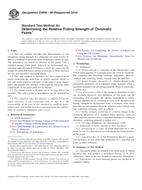Potřebujeme váš souhlas k využití jednotlivých dat, aby se vám mimo jiné mohly ukazovat informace týkající se vašich zájmů. Souhlas udělíte kliknutím na tlačítko „OK“.
ASTM D4838-88(2010)
Standard Test Method for Determining the Relative Tinting Strength of Chromatic Paints
Automaticky přeložený název:
Standardní zkušební metoda pro stanovení relativní barvící schopnost chromatické Barvy
NORMA vydána dne 1.6.2010
Informace o normě:
Označení normy: ASTM D4838-88(2010)
Poznámka: NEPLATNÁ
Datum vydání normy: 1.6.2010
Kód zboží: NS-28832
Počet stran: 5
Přibližná hmotnost: 15 g (0.03 liber)
Země: Americká technická norma
Kategorie: Technické normy ASTM
Kategorie - podobné normy:
Anotace textu normy ASTM D4838-88(2010) :
Keywords:
artists´ paints, chromate coatings, tinting strength, Latex paints, Pigments (general properties), Solventborne paints/coatings, Tinting strength, Absorptive coatings, Artists&apos, materials/applications, Chromate coatings, Color--paints/related coatings/materials, ICS Number Code 87.040 (Paints and varnishes)
Doplňující informace
| Significance and Use | ||||||||||
|
Tinting strength may be one factor in judging the relative economic value of paints, since pigment concentration contributes to strength in a major way; other factors are formulation and color development in grinding. The user may also select products for other properties, such as transparency, that are accompanied by different tinting strengths. The results of this test method may be used for production control or quality comparisons. The product with the greatest or the least tinting strength may not be the most desirable for a given artistic use. For example, low tinting strength may lead to the need to use an excessively high pigment concentration to obtain a desired color effect, and this may lead to defects in the dry paint film. This test method applies only to single-pigment paints. The tinting strength of paints that contain two or more chromatic pigments with different optical properties cannot be evaluated by this test method. The term “similar chemical type” used in 1.1 does not limit the ingredients in the paints to identity, but refers to compatibility in the case of vehicles and to similarity in the case of pigment types. While the instrumental evaluation of tinting strength is described, visual comparisons can also be used, with lower precision, and should be made to provide confirmation of the instrumental and computational results. If the sample and standard are widely different in appearance when prepared at the same ratio of chromatic to white paint, another sample should be prepared to bring the two closer in appearance, to obtain the most accurate results. The quantities of chromatic and white paints mixed must be accurately known, on either a weight or a volume basis, but the concentration of pigment in the chromatic paint need not be known. When the paints being compared have the same vehicle and pigment (same Colour Index name and number) the values of uncorrected tinting strength from 9.1 and corrected tinting strength from 9.2 should be nearly the same. If they are not, an average of the two tinting strengths is recommended as the best estimate of the true value, and a range provides a measure of the magnitude of the uncertainty, which is due to differences in hue or chroma, or both, between the paints. Strictly speaking, the Kubelka-Munk-type analysis of this test method should not be applied to the tristimulus filter readings used, but only to spectral data. For the purposes of the relative comparisons of this test method, however, the errors introduced by the calculations used cancel to an adequate degree. |
||||||||||
| 1. Scope | ||||||||||
|
1.1 This test method describes the determination of the absorption tinting strength of a chromatic test paint relative to that of a standard or reference paint of the same chemical type. The procedures are based on dilution of the paints with a standard mixing white paint, followed by instrumental measurement and calculation. Provision is made for correcting the results for small differences in hue or chroma, or both, between the test and reference chromatic paints. 1.2 This test method is intended for the comparison of paints containing the same type of vehicle (acrylic, alkyd, or oil) and single-pigment colorants of the same Colour Index name and number. The amounts of the pigment and of the other components of the paint need not be known. 1.3 The values stated in SI units are to be regarded as the standard. The values given in parentheses are for information only. 1.4 This standard does not purport to address all of the safety concerns, if any, associated with its use. It is the responsibility of the user of this standard to establish appropriate safety and health practices and determine the applicability of regulatory limitations prior to use. |
||||||||||
| 2. Referenced Documents | ||||||||||
|
Doporučujeme:
EviZak - všechny zákony včetně jejich evidence na jednom místě
Poskytování aktuálních informací o legislativních předpisech vyhlášených ve Sbírce zákonů od roku 1945.
Aktualizace 2x v měsíci !
Chcete vědět více informací? Podívejte se na tuto stránku.




 Cookies
Cookies
